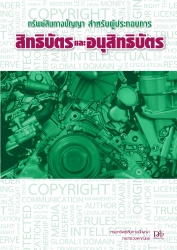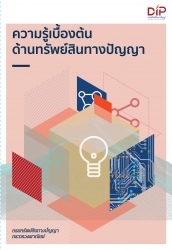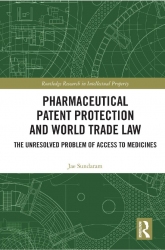
Author : กรมทรัพย์สินทางปัญญา
Publishing Date : Aug 09, 2017
ความรู้เกี่ยวกับสิทธิบัตรและอนุสิทธิบัตรรวมถึงสนธิสัญญาความร่วมมือด้านสิทธิบัตร (PCT)

Author : กรมทรัพย์สินทางปัญญา
Publishing Date : Jan 12, 2018
รวมกฎหมาย พระราชบัญญัติทรัพย์สินทางปัญญาที่แก้ไขปรับปรุง (เลือกอ่านแบบหน้าเดี่ยว ตัวหน้าสือจะขยาย อ่านได้สะดวก)

Author : กรมทรัพย์สินทางปัญญา
Publishing Date : Jan 15, 2018
ความรู้เบื้องต้นเกี่ยวกับทรัพย์สินทางปัญญาของไทย
Author : สถาบันทรัพย์สินทางปัญยาแห่งจุฬาลงกรณ์มหาวิทยาลัย
Publishing Date : Nov 30, 2018
หนังสือรายงานการวิเคราะห์แนวโน้มเทคโนโลยีและอุตสาหกรรม อุตสาหกรรมเชื้อเพลิงชีวภาพและเคมีชีวภาพ
Author : สถาบันทรัพย์สินทางปัญยาแห่งจุฬาลงกรณ์มหาวิทยาลัย
Publishing Date : Dec 03, 2018
หนังสือรายงานการวิเคราะห์แนวโน้มเทคโนโลยีและอุตสาหกรรม "หุ่นยนต์เพื่ออุตสาหกรรม"
Author : สถาบันทรัพย์สินทางปัญยาแห่งจุฬาลงกรณ์มหาวิทยาลัย
Publishing Date : Dec 03, 2018
หนังสือรายงานการวิเคราะห์แนวโน้มเทคโนโลยีและอุตสาหกรรม "อุตสาหกรรมยานยนต์ใหม่"
Author : สถาบันทรัพย์สินทางปัญยาแห่งจุฬาลงกรณ์มหาวิทยาลัย
Publishing Date : Dec 03, 2018
หนังสือรายงานการวิเคราะห์แนวโน้มเทคโนโลยีและอุตสาหกรรม "อุตสาหกรรมอิเล็กทรอนิกส์อัจฉริยะ"

Author : The ASEAN Secretariat
Publishing Date : Mar 12, 2020
This Handbook is designed for business people of ASEAN Member States, Australia and New
Zealand.
In aid of understanding, some examples have been provided, but these are mere illustrations and do
not provide judgment and do not constitute commercial or legal advice. Views or conclusions may
have also been expressed but these should NOT be taken as legal or commercial advice. Any part of
the content of this publication (including images, graphics, trademarks or logos) is only intended for
informational and educational and educational purpose only.
The author and the ASEAN Secretariat have taken due diligence in the preparation of this
publication. However, they shall not be held liable for any omissions or inaccuracies in the content of
this publication. Neither the authors, the ASEAN Secretariat, Australian and New Zealand
Governments accept any liability for any claims, loss or expenses that may arise or arising from use

Author : Weinian Hu
Publishing Date : May 08, 2017
With reference to China, this book examines the course of international patent rights harmonisation; its characteristics as well as impediments. It evaluates the case of China’s patent law development over the course of the last three decades by drawing on the most up-to-date Chinese language sources. In the process, the volume focuses on China’s patent legislation, its achievements and weaknesses, as well as the intrinsic limitations, especially as far as enforcement is concerned. The author pays close attention to the unique societal background in China, a country that did not provide constitutional recognition to private property rights until 2004 and where a property law entered into force as late as 2013, 30 years after the first promulgation of the patent law.
Global trade policy makers, IP professionals and businesses will benefit from the insights presented by the chapters as they will help them to appreciate the achievements and the controversies pursuant to China’s efforts in patent protection. While serving as a useful case study for countries seeking to leverage patent protection as a driver for economic development, the book will equally facilitate Chinese legislature to reflect on its patent legislation development, specifically on legislative policy choices.
An additional analytical strength of the volume is that it compares the Chinese patent legislation with the American Invents Act and the European Patent Convention. It discovers the differences between the three patent legislations by using the minimum patent protection standards set down by the TRIPS Agreement as the benchmark. The results of the comparisons suggest that China has successfully harmonised its patent legislation with the global patent protection system, and often opts for higher patent protection standards. The book also considers whether China could learn lessons from Japan and India in their respective patent legislation and policy choices.
With China undertaking a fourth patent law amendment, the provisions contained in the second draft of the Patent Law 2015, which was published in December 2015, are included in the analysis.

Author : Jae Sundaram
Publishing Date : May 08, 2018
Patents, including pharmaceutical patents, enjoy extended protection for twenty years under the TRIPs Agreement. The Agreement has resulted in creating a two-tier system of the World Trade Organisation Member States, and its implementation has seen the price of pharmaceutical products skyrocket, putting essential medicines beyond the reach of the common man. The hardest hit populations come from the developing and least developed countries, which have either a weak healthcare system or no healthcare at all, where access to essential and affordable medicines is extremely difficult to achieve.
Pharmaceutical Patent Protection and World Trade Law studies the problems faced by these countries in obtaining access to affordable medicines for their citizens in light of the TRIPS Agreement. It explores the opportunities that are still open for some developing countries to utilise the flexibilities available under the TRIPS Agreement in order to mitigate the damage caused by it. The book also examines the interrelationship between the world governing bodies, and the right to health contained in some of the developing country’s national constitutions.

Author : Maureen O'Sullivan
Publishing Date : Jun 19, 2019
This book critiques the decision-making process in Article 53(a) of the European Patent Convention. To date, such decisions have been taken at high levels of expertise without much public involvement. The book eschews traditional solutions, such as those found within legislative, judicial and patent office realms and instead develops a radical blueprint for how these decisions can be put to the public. By examining wide-scale models of participatory democracy and deliberation, this book fills a significant gap in the literature. It will be invaluable for patent lawyers, academics, practitioners and intellectual property and patent officials.
123NextLast

